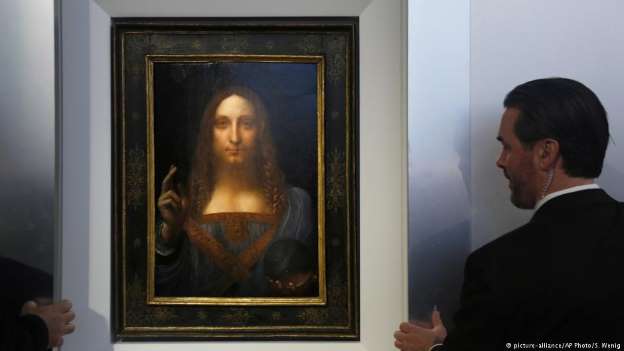 |
| Leonardo da Vinci's "Salvator Mundi" |
With just under two weeks to go before the show opens, there are now serious doubts as to whether the star of the exhibition will be included, as the Paris museum had hoped.
The world’s most expensive painting, a depiction of Jesus in Renaissance dress, which sold at auction in 2017 for $450m, would draw huge crowds. Described as a devotional counterpart to the Mona Lisa, Leonardo’s most famous work, it is said to have an “extraordinary, communicative presence”.
But the arts world is awash with rumours that its appearance looks unlikely. The Art Newspaper goes further and claims the painting will not feature. A spokeswoman for the Louvre told the Observer: “I confirm the Louvre has asked for the loan of the Salvator Mundi. We don’t have the answer yet and thus, don’t have any further comment.”
A no show would be the latest twist in the extraordinary saga of a painting that has attracted as much controversy, intrigue and division as it has critical acclaim. Questions over its authenticity have raged among art historians for more than a decade.
Once attributed to the “school of Giovanni Boltraffio”, an early Renaissance painter who was a pupil of Leonardo, it was then upgraded to “a work by Boltraffio” when sold for £45 in 1958 at an auction in London.
A New York art historian and dealer, Robert B Simon, bought it from a New Orleans auction house for just $1,175 in 2005 and it was attributed to Leonardo in 2011.
“There are a host of reasons why I believe 100% in Leonardo’s authorship of the Salvator Mundi – most of all the inimitable style, unique iconography and phenomenal quality of the painting,” Simon told the Observer. “To these one could add the peculiarities of Leonardo’s technique, the relationship of the painting to autograph drawings, and the evidence of the work’s history. However, for me the most compelling reason to believe in the painting is neither scholarly nor scientific: it comes from its sense of profound spirituality that is conveyed from artist to viewer across 500 years.”
Today, though, some still question the attribution although not, according to Simon, the Louvre. “I know that the painting was requested for the Louvre exhibition – and as a work by Leonardo,” he said. “But obviously the decision about whether to loan it is the owner’s to make. And I have no knowledge of his decision.”
Indeed, who actually owns the painting is another source of contention. It was rumoured to be in the hands of the Abu Dhabi royal family. More recently there has been speculation that it is on the super-yacht of Mohammed bin Salman, Saudi Arabia’s Crown Prince who has been forced to deny his involvement in the killing of journalist Jamal Khashoggi.
The painting’s previous known owner was Russian oligarch Dmitry Rybolovlev who bought it on 3 May 2013 for $127.5m, following substantial restoration. Rybolovlev was later incensed to learn that his art adviser, a Swiss businessman, Yves Bouvier, had allegedly acquired the painting on 2 May 2013 from a consortium led by Simon in a private sale brokered by Sotheby’s. Court documents allege Bouvier paid Sotheby’s $83m before flipping the painting to Rybolovlev for a markup of more than 50%.
Rybolovlev alleges that Bouvier repeated the same trick with no fewer than 38 art masterworks he acquired, including paintings by Picasso, Gauguin, Klimt, Rothko and Modigliani. In a lawsuit launched against Sotheby’s for its part in what he alleges was “the largest art fraud in history”, Rybolovlev claims he was defrauded of more than $1bn.
Sotheby’s, which did not return requests for comment, contests the claims, as does Bouvier.
The extraordinary alacrity with which the painting’s value sky-rocketed, and the opaque circumstances surrounding its sale and ownership, have prompted calls for the art market to be more heavily regulated.
But Simon, who this week publishes a new book he has co-authored about the painting – Leonardo’s Salvator Mundi and the Collecting of Leonardo in the Stuart Courts – which examines evidence that its previous owners included English royalty, expressed scepticism.
“I don’t see how any art market regulation would have a bearing on the controversy surrounding the sale of the work. The sale of a valuable work of art like the Leonardo is governed by existing laws similar to and often the same as those that concern other valuable properties – whether art, gold, jewellery, land, a building, yacht, or an airplane.“
The Salvator Mundi was due to appear at the Louvre museum in Abu Dhabi last year. Then, as now, its no show invited speculation as to where it was really hanging. It could be that the most expensive painting in history – and arguably the most controversial – is not on display anywhere.
“I do not know where the painting is,” Simon said. “Although I had heard that some months ago it was being kept in a secure art storage facility in Switzerland.”






